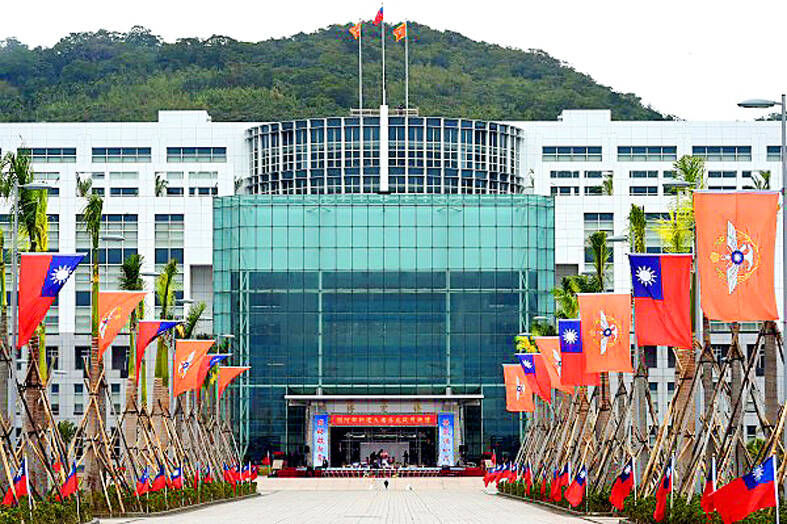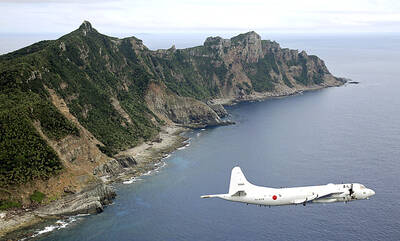Taiwan yesterday reported renewed Chinese military activity near the nation, with 12 Chinese People’s Liberation Army (PLA) aircraft crossing the median line of the Taiwan Strait the day after US Secretary of State Antony Blinken ended his visit to China.
“We detected activities from 22 PLA aircraft ... since 9:30am,” the Ministry of National Defense said in a statement.
It said that 12 aircraft had crossed the median line and “entered Taiwan’s northern and central air defense identification zone.”

Photo courtesy of the Ministry of National Defense
The median line once served as an unofficial border that neither sides’ militaries crossed, but China’s air force now regularly sends aircraft over it.
Beijing says it does not recognize the line’s existence.
The aircraft were involved in “joint combat readiness patrols” with Chinese warships, the ministry said.
Taiwanese aircraft and ships responded “appropriately,” it added.
It did not provide details.
Blinken traveled to China from Wednesday to Friday to discuss key issues between Washington and Beijing and a range of regional and global matters.
During the meeting between Blinken and Chinese President Xi Jinping (習近平) on Friday, Blinken reiterated that there has been no change to the US’ “one China” policy, which is guided by the Taiwan Relations Act, the Three Joint Communiques and the “six assurances,” US Department of State spokesperson Matthew Miller said.
Blinken also expressed concerns about China’s destabilizing actions near the Second Thomas Shoal (Renai Shoal, 仁愛暗沙), and the importance of upholding the rule of law and freedom of navigation in the South China Sea, Miller said.
Blinken told Xi that the US would continue to take necessary actions to defend its interests and values, and those of its allies and partners, he said.
The PLA’s military activity yesterday also comes as the US and Philippines are conducting joint military exercises, including near the potential flashpoints in the South China Sea and the Taiwan Strait.
The joint drills involve simulating the retaking of enemy-occupied islands in areas around Taiwan.

MISINFORMATION: The generated content tends to adopt China’s official stance, such as ‘Taiwan is currently governed by the Chinese central government,’ the NSB said Five China-developed artificial intelligence (AI) language models exhibit cybersecurity risks and content biases, an inspection conducted by the National Security Bureau (NSB) showed. The five AI tools are: DeepSeek, Doubao (豆包), Yiyan (文心一言), Tongyi (通義千問) and Yuanbao (騰訊元寶), the bureau said, advising people to remain vigilant to protect personal data privacy and corporate business secrets. The NSB said it, in accordance with the National Intelligence Services Act (國家情報工作法), has reviewed international cybersecurity reports and intelligence, and coordinated with the Ministry of Justice Investigation Bureau and the National Police Agency’s Criminal Investigation Bureau to conduct an inspection of China-made AI language

LIMITS: While China increases military pressure on Taiwan and expands its use of cognitive warfare, it is unwilling to target tech supply chains, the report said US and Taiwan military officials have warned that the Chinese People’s Liberation Army (PLA) could implement a blockade within “a matter of hours” and need only “minimal conversion time” prior to an attack on Taiwan, a report released on Tuesday by the US Senate’s China Economic and Security Review Commission said. “While there is no indication that China is planning an imminent attack, the United States and its allies and partners can no longer assume that a Taiwan contingency is a distant possibility for which they would have ample time to prepare,” it said. The commission made the comments in its annual

‘TROUBLEMAKER’: Most countries believe that it is China — rather than Taiwan — that is undermining regional peace and stability with its coercive tactics, the president said China should restrain itself and refrain from being a troublemaker that sabotages peace and stability in the Indo-Pacific region, President William Lai (賴清德) said yesterday. Lai made the remarks after China Coast Guard vessels sailed into disputed waters off the Senkaku Islands — known as the Diaoyutai Islands (釣魚台) in Taiwan — following a remark Japanese Prime Minister Sanae Takaichi made regarding Taiwan. Takaichi during a parliamentary session on Nov. 7 said that a “Taiwan contingency” involving a Chinese naval blockade could qualify as a “survival-threatening situation” for Japan, and trigger Tokyo’s deployment of its military for defense. Asked about the escalating tensions

DISPUTE: A Chinese official prompted a formal protest from Tokyo by saying that ‘the dirty head that sticks itself out must be cut off,’ after Takaichi’s Taiwan remarks Four armed China Coast Guard vessels yesterday morning sailed through disputed waters controlled by Japan, amid a diplomatic spat following Japanese Prime Minister Sanae Takaichi’s comments on Taiwan. The four ships sailed around the Senkaku Islands — known as the Diaoyutai Islands (釣魚台) to Taiwan, and which Taiwan and China also claim — on Saturday before entering Japanese waters yesterday and left, the Japan Coast Guard said. The China Coast Guard said in a statement that it carried out a “rights enforcement patrol” through the waters and that it was a lawful operation. As of the end of last month,